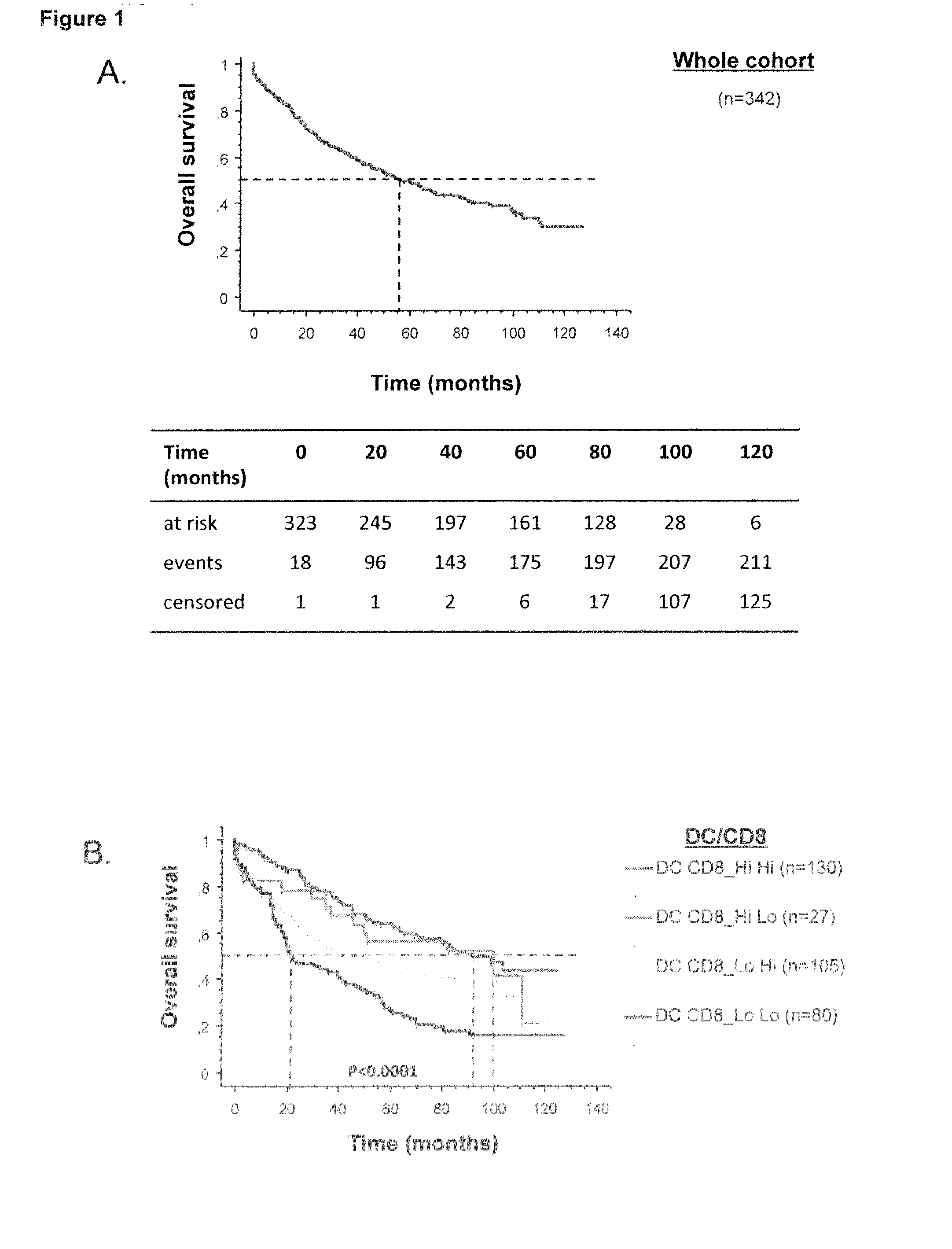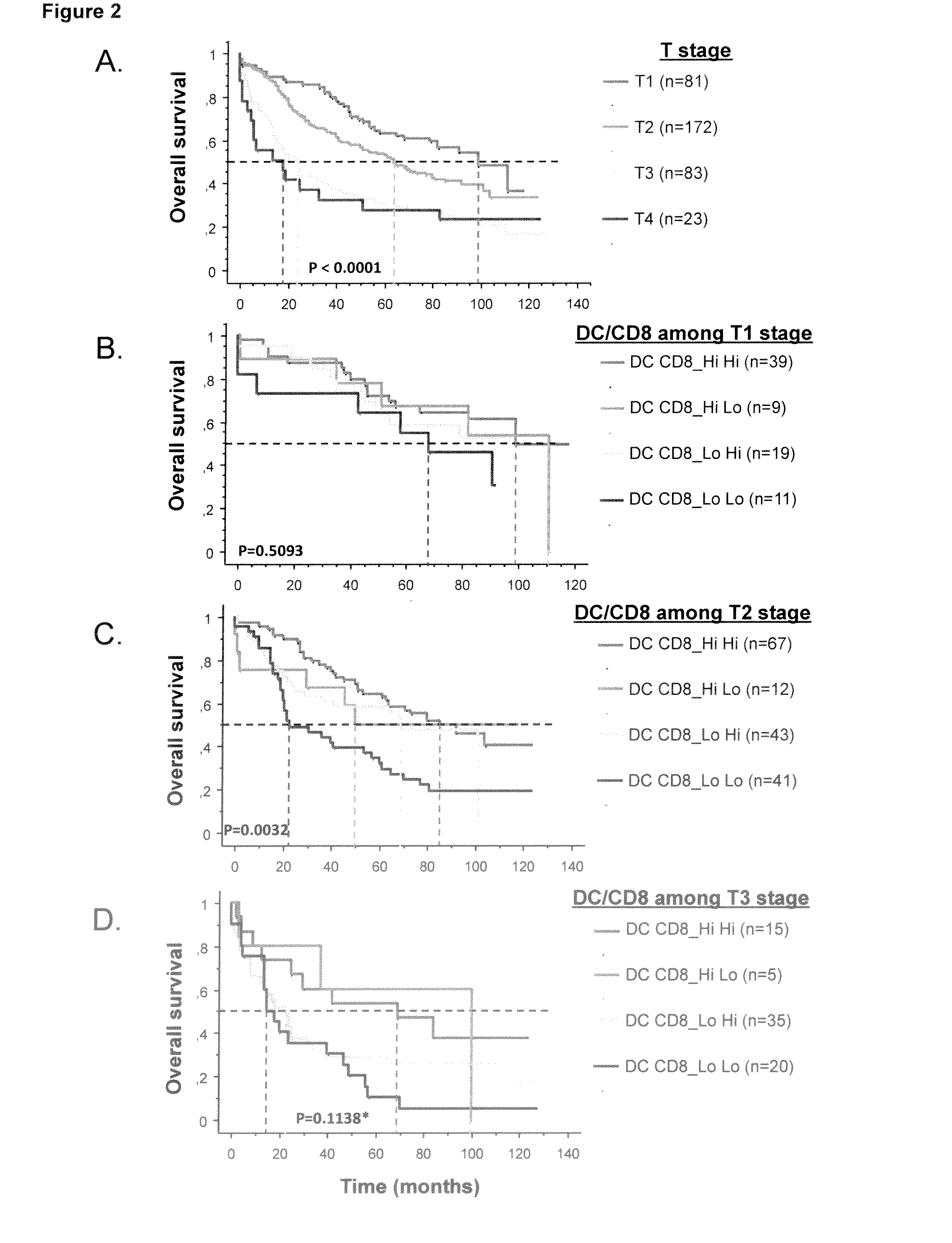Method for the Prognosis of Survival Time of a Patient Suffering from a Solid Cancer
a solid cancer and prognosis technology, applied in the field of in vitro methods for the prognosis of survival time of a patient suffering from a solid cancer, can solve the problems of inefficiency of tumor eradication by the immune system, and achieve the effects of avoiding or minimizing side effects, good therapy outcome, and high probability
- Summary
- Abstract
- Description
- Claims
- Application Information
AI Technical Summary
Benefits of technology
Problems solved by technology
Method used
Image
Examples
example 1
Patients
[0064]Fresh (n=54 patients), frozen (n=28 patients), and paraffin-embedded (n=376 patients) lung tumor samples were obtained from NSCLC patients who underwent a complete surgical resection of their lung tumors at Institut Mutualiste Montsouris or Hotel Dieu Hospital (Paris, France). 376 NSCLC patients (stages I to IV, UICC TNM classification 2009) operated between Jun. 15, 2001 and Nov. 26, 2004 were retrieved retrospectively. The classification of the tumor grade was made following the recommendation of the 7th edition of the TNM classification of malignant tumors published by the International Union Against Cancer and the American Joint Committee on Cancer (Sobin, Cancer, 2010). Patients who received neo-adjuvant chemotherapy or radiotherapy were ineligible. The observation time of the cohort was the interval between the surgery and the last contact (last follow-up or death of the patient). At the completion of the study, the minimal clinical follow-up was 90 months for th...
example 2
Patients
[0080]Paraffin-embedded lung tumor samples (n=372 tumors) were obtained from NSCLC patients (stages I to IV, UICC TNM classification 2009), who underwent a complete surgical resection of their lung tumors at Institut Mutualiste Montsouris or Hotel Dieu Hospital (Paris, France). Patients with an Eastern Cooperative Oncology Group performance status (Finkelstein et al., Am J Clin Oncol, 1988) ≦1 were eligible. The classification of the tumor grade was made following the recommendation of the 7th edition of the TNM classification of malignant tumors published by the International Union Against Cancer and the American Joint Committee on Cancer (Sobin, Cancer, 2010). Patients operated between Jun. 15, 2001 and Dec. 31, 2004 were retrieved retrospectively. Patients who received neo-adjuvant chemotherapy or radiotherapy were ineligible. The observation time of the cohort was the interval between the diagnosis and the last contact (last follow-up or death of the patient). At the com...
PUM
| Property | Measurement | Unit |
|---|---|---|
| cell density | aaaaa | aaaaa |
| density | aaaaa | aaaaa |
| survival time | aaaaa | aaaaa |
Abstract
Description
Claims
Application Information
 Login to View More
Login to View More - R&D
- Intellectual Property
- Life Sciences
- Materials
- Tech Scout
- Unparalleled Data Quality
- Higher Quality Content
- 60% Fewer Hallucinations
Browse by: Latest US Patents, China's latest patents, Technical Efficacy Thesaurus, Application Domain, Technology Topic, Popular Technical Reports.
© 2025 PatSnap. All rights reserved.Legal|Privacy policy|Modern Slavery Act Transparency Statement|Sitemap|About US| Contact US: help@patsnap.com



